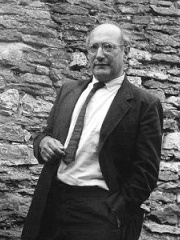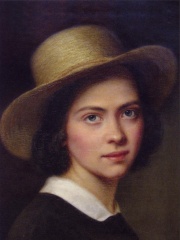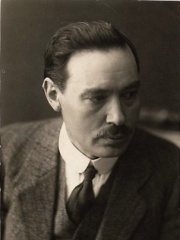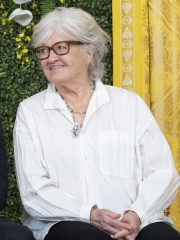



The Most Famous
PAINTERS from Latvia
This page contains a list of the greatest Latvian Painters. The pantheon dataset contains 2,023 Painters, 5 of which were born in Latvia. This makes Latvia the birth place of the 38th most number of Painters behind Croatia, and South Africa.
Top 5
The following people are considered by Pantheon to be the most legendary Latvian Painters of all time. This list of famous Latvian Painters is sorted by HPI (Historical Popularity Index), a metric that aggregates information on a biography's online popularity.

1. Mark Rothko (1903 - 1970)
With an HPI of 74.57, Mark Rothko is the most famous Latvian Painter. His biography has been translated into 61 different languages on wikipedia.
Mark Rothko ( ROTH-koh; Markus Yakovlevich Rothkowitz until 1940; September 25, 1903 – February 25, 1970) was an American abstract painter. He is best known for his color field paintings that depicted irregular and painterly rectangular regions of color, which he produced from 1949 to 1970. Although Rothko did not personally subscribe to any one school, he is associated with the American abstract expressionism movement of modern art. Born to a Jewish family in Daugavpils, Latvia, then part of the Russian Empire, Rothko emigrated with his parents and siblings to the United States, arriving at Ellis Island in late 1913 and originally settling in Portland, Oregon. He moved to New York City in 1923 where his youthful period of artistic production dealt primarily with urban scenery. In response to World War II, Rothko's art entered a transitional phase during the 1940s, where he experimented with mythological themes and Surrealism to express tragedy. Toward the end of the decade, Rothko painted canvases with regions of pure color which he further abstracted into rectangular color forms, the idiom he would use for the rest of his life. In his later career, Rothko executed several canvases for three different mural projects. The Seagram murals were to have decorated the Four Seasons Restaurant in the Seagram Building, but Rothko eventually grew disgusted with the idea that his paintings would be decorative objects for wealthy diners and refunded the lucrative commission, donating the paintings to museums including the Tate Gallery. The Harvard Mural series was donated to a dining room in Harvard's Holyoke Center (now Smith Campus Center); their colors faded badly over time due to Rothko's use of the pigment lithol red together with regular sunlight exposure. The Harvard series has since been restored using a special lighting technique. Rothko contributed 14 canvases to a permanent installation at the Rothko Chapel, a non-denominational chapel in Houston, Texas. Although Rothko lived modestly for much of his life, the resale value of his paintings grew tremendously in the decades following his suicide in 1970. His painting No. 6 (Violet, Green and Red) sold in 2014 for $186 million.

2. Julie Wilhelmine Hagen-Schwarz (b. 1824)
With an HPI of 61.18, Julie Wilhelmine Hagen-Schwarz is the 2nd most famous Latvian Painter. Her biography has been translated into 26 different languages.
Julie Wilhelmine Hagen-Schwarz (27 October [O.S. 5] 1824 – 20 October [O.S. 7] 1902) was a Baltic German painter, primarily of portraits.

3. Vilhelms Purvītis (1872 - 1945)
With an HPI of 59.40, Vilhelms Purvītis is the 3rd most famous Latvian Painter. His biography has been translated into 20 different languages.
Vilhelms Purvītis (3 March 1872 – 14 January 1945) was a landscape painter and educator who founded the Latvian Academy of Art and was its rector from 1919 to 1934.

4. Janis Rozentāls (1866 - 1916)
With an HPI of 59.09, Janis Rozentāls is the 4th most famous Latvian Painter. Her biography has been translated into 21 different languages.
Janis Rozentāls (March 18, 1866 – December 26, 1916) was a Latvian painter.

5. Vija Celmins (b. 1938)
With an HPI of 55.15, Vija Celmins is the 5th most famous Latvian Painter. Her biography has been translated into 19 different languages.
Vija Celmins ( VEE-yə SEL-məns; Latvian: Vija Celmiņa; Latvian pronunciation: [ˈvija ˈt̪͡s̪ɛlmiɲa]; born October 25, 1938) is a Latvian American visual artist best known for photo-realistic paintings and drawings of natural environments and phenomena such as the ocean, spider webs, star fields, and rocks. Her earlier work included pop sculptures and monochromatic representational paintings. Based in New York City, she has been the subject of over forty solo exhibitions since 1965, and major retrospectives at the Museum of Modern Art, Whitney Museum of American Art, Los Angeles County Museum of Art, San Francisco Museum of Modern Art, Institute of Contemporary Arts, London and the Centre Pompidou, Paris.
People
Pantheon has 5 people classified as Latvian painters born between 1824 and 1938. Of these 5, 1 (20.00%) of them are still alive today. The most famous living Latvian painters include Vija Celmins. The most famous deceased Latvian painters include Mark Rothko, Julie Wilhelmine Hagen-Schwarz, and Vilhelms Purvītis.
Living Latvian Painters
Go to all RankingsDeceased Latvian Painters
Go to all RankingsMark Rothko
1903 - 1970
HPI: 74.57
Julie Wilhelmine Hagen-Schwarz
1824 - Present
HPI: 61.18
Vilhelms Purvītis
1872 - 1945
HPI: 59.40
Janis Rozentāls
1866 - 1916
HPI: 59.09
Overlapping Lives
Which Painters were alive at the same time? This visualization shows the lifespans of the 3 most globally memorable Painters since 1700.

